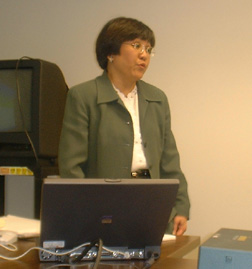E&REM doctoral candidate Daisy M. Ligon recently defended her doctoral research on “Use of Dynamic Simulation and Other Computer-Aided Analytical Tools to Improve Environmental Impact Assessments.” Dr. Ligon’s research, which was sponsored by the Transportation Environmental Research Program of the U.S. Federal Highway Administration, used the U.S. 17 New Bern Bypass Project in Craven County, North Carolina to test her hypotheses.
Dr. Daisy Ligon of the Mitretek Corporation, defends her doctoral research on the Use of Computer-Aided Analytical Tools to Improve Environmental Impact Assessments |
Dr. Ligon, who works for the Mitretek Corporation, said that “the study was undertaken to assist the Federal Highway Administration in understanding the potential application of computer-aided EIA tools as a means of improving understanding of true project impacts, and in enhancing public communications in the environmental assessment process.”

|
A major thrust of the research was directed toward determining whether or not certain interactive tools can not only provide better insights on problems, but also can assist stakeholders, particularly those who may not be familiar with the National Environmental Policy Act (NEPA) process.
A summary of the results of Dr. Ligon's work was published recently in the Federal Facilities Environmental Journal (Ligon, D.M. and Deason, J.P. "Improving Public Communication in Environmental Impact Assessments”) |
The objectives of the research were to determine the effectiveness of an integrated and dynamic approach that captures the causal relationships and interactions among various project-related environmental factors in assessing environmental impacts, and to identify improvements to EIA tools that could assist stakeholders in understanding the major effects of various environmental factors as well as facilitating dialogue among such stakeholders.

Professors Robert Romano and jack Harrald examine Dr. Ligon at her final defense. |
Dynamic simulation models were developed to quantify the effects of the selected project on various environmental factors. Other analytical tools that could be used in conjunction with the basic dynamic simulation models were investigated, including Geographic Information Systems (GIS), hydrologic simulation models, and flood damage analysis.


